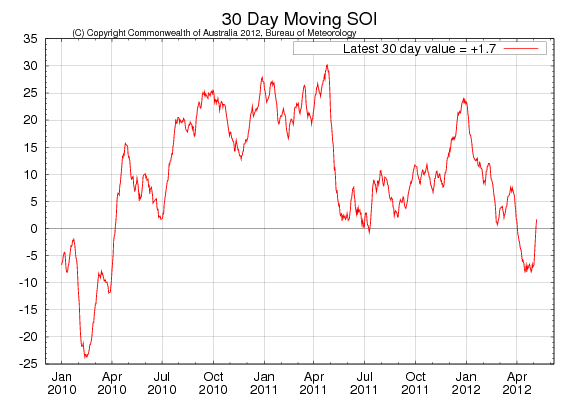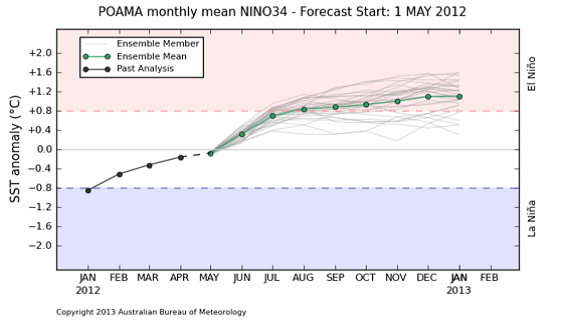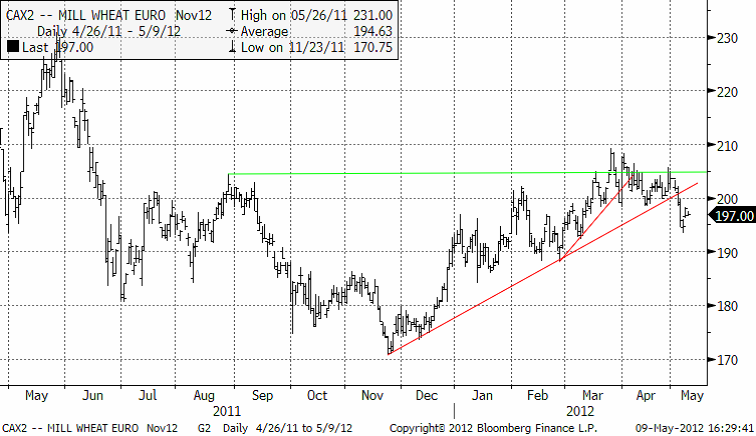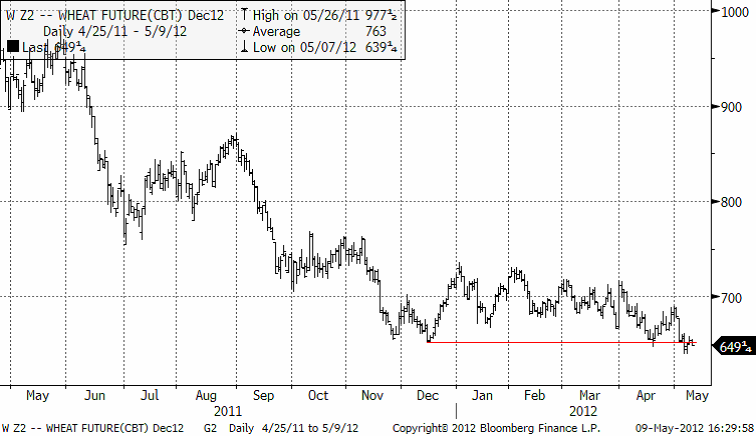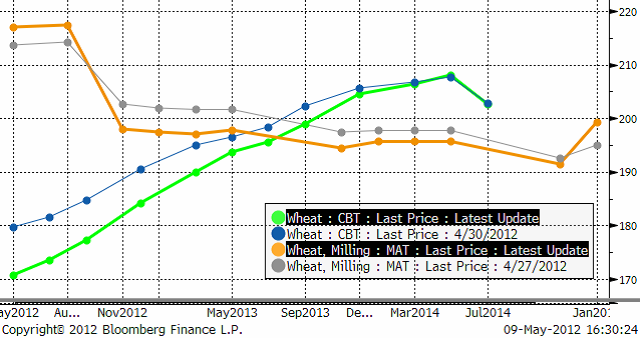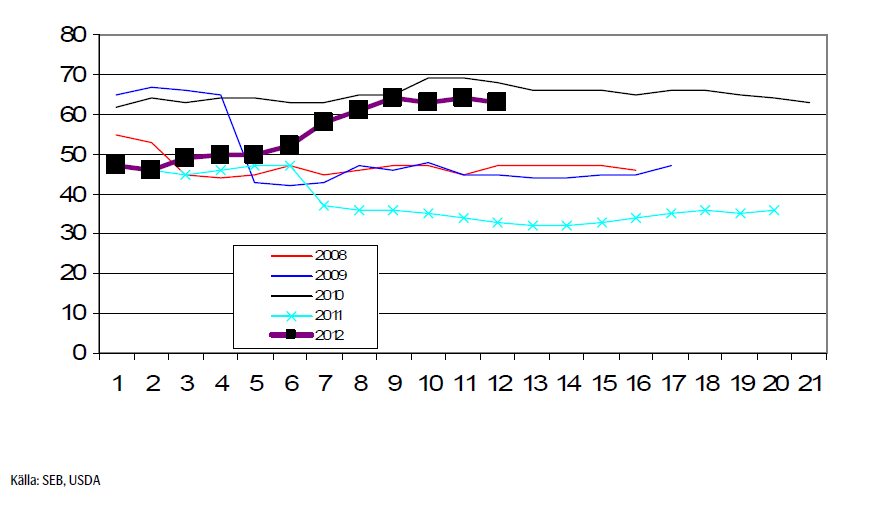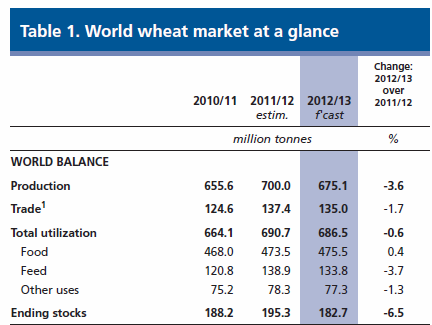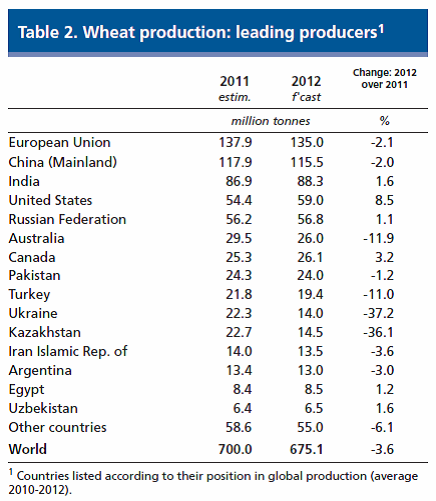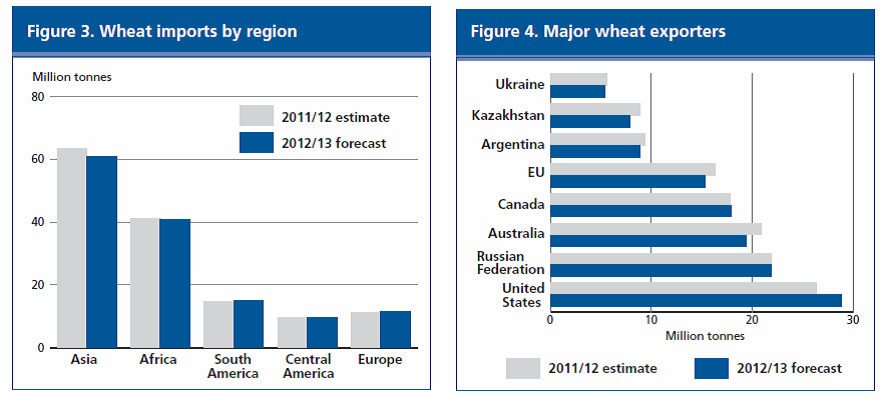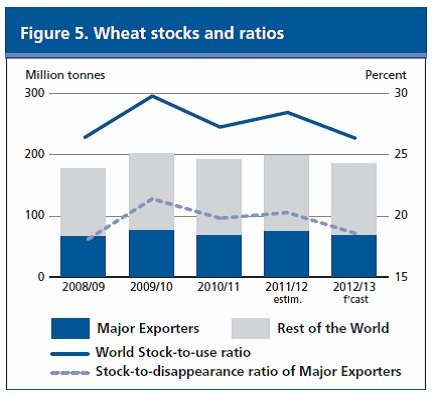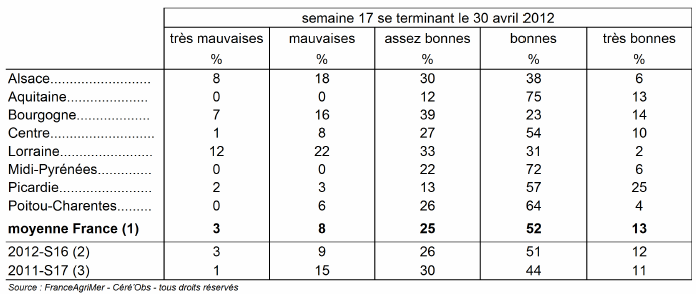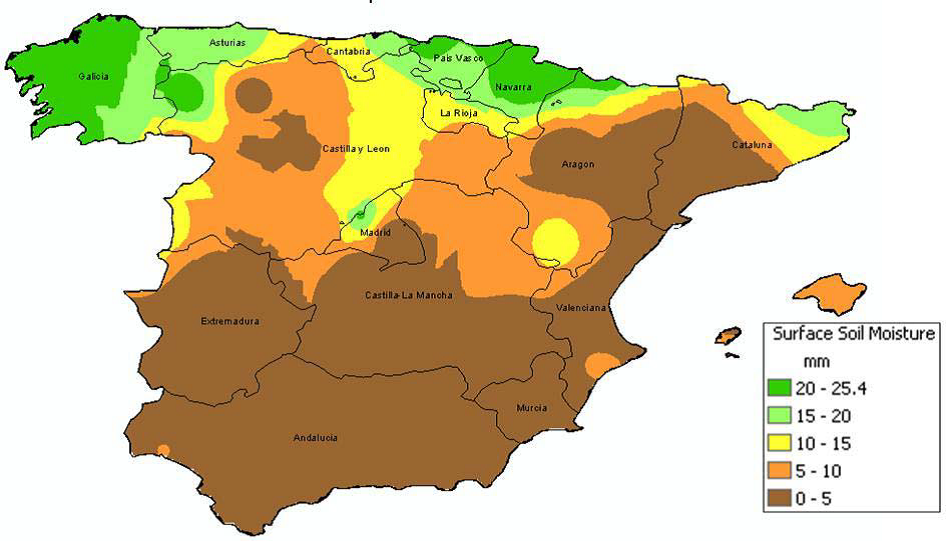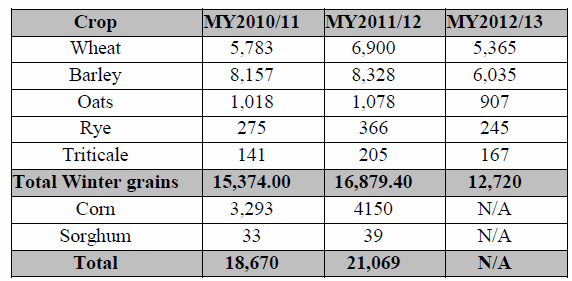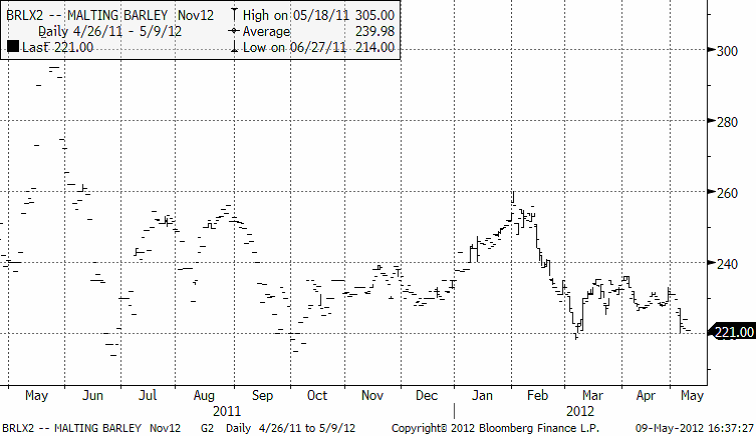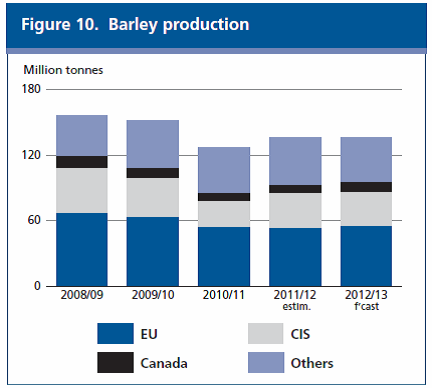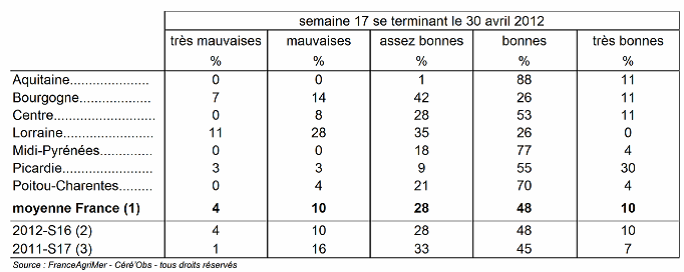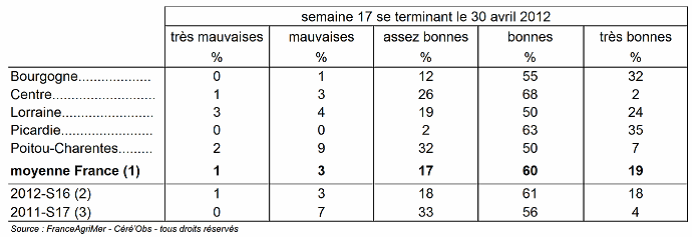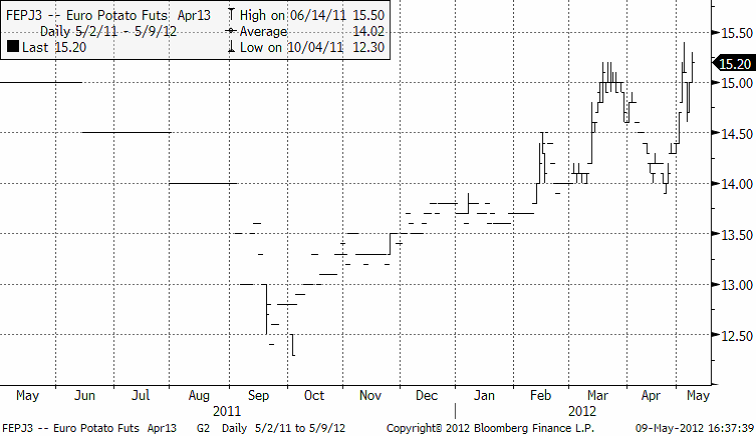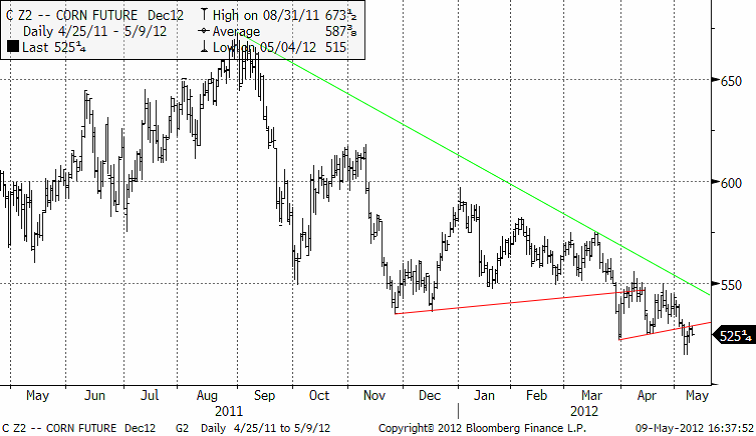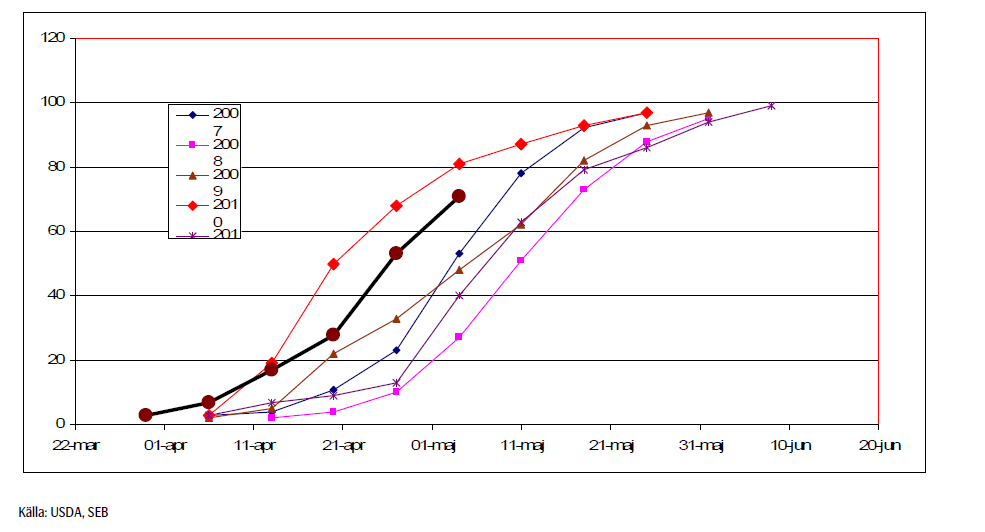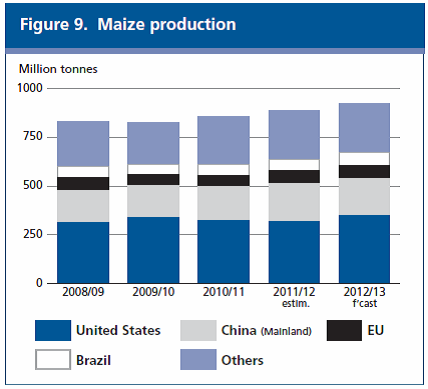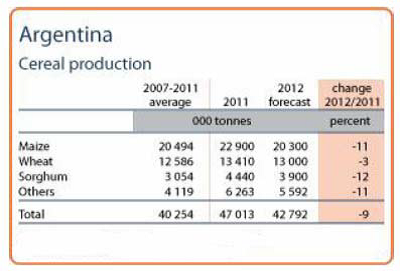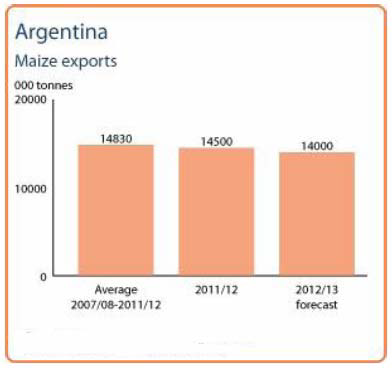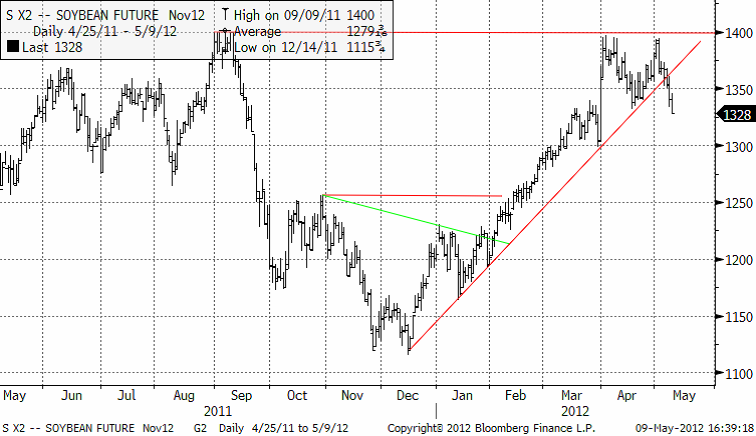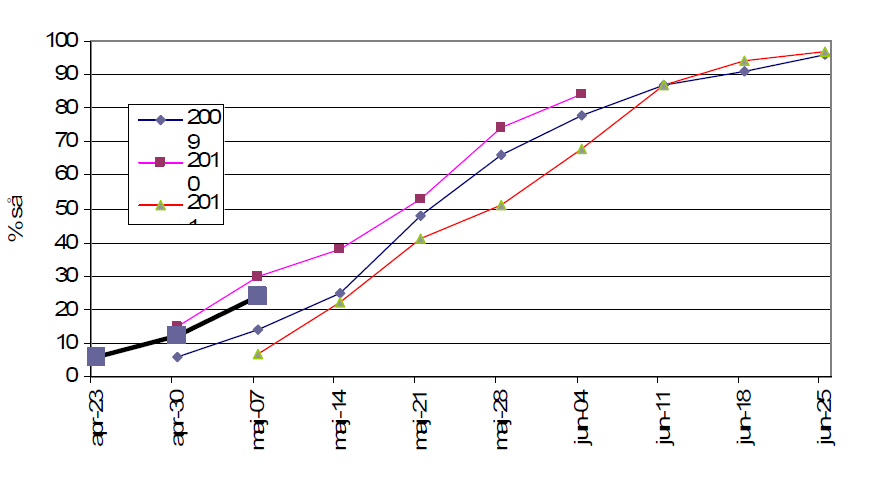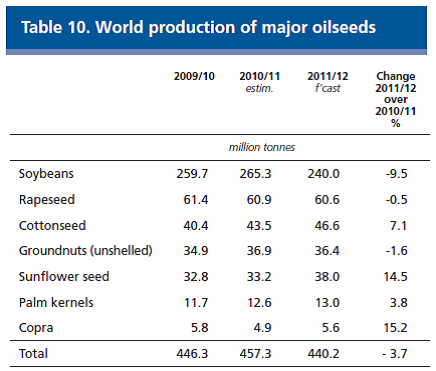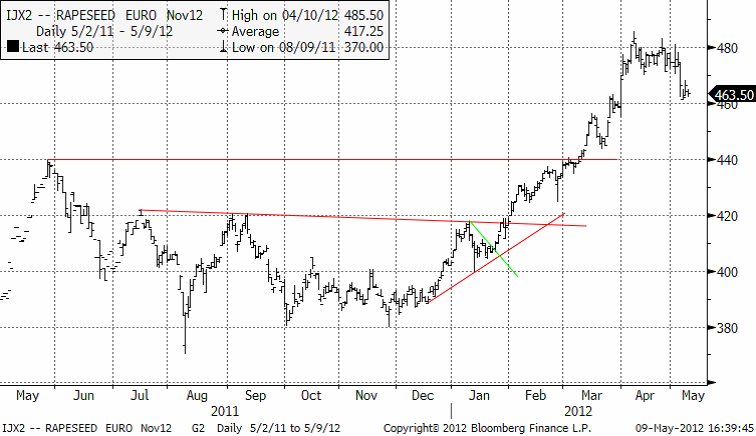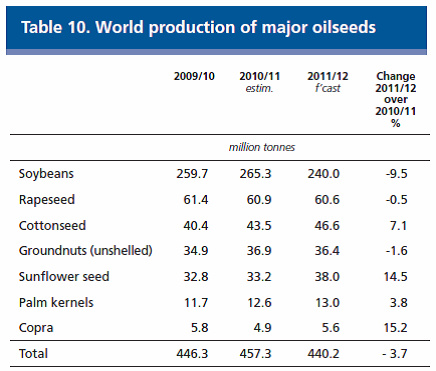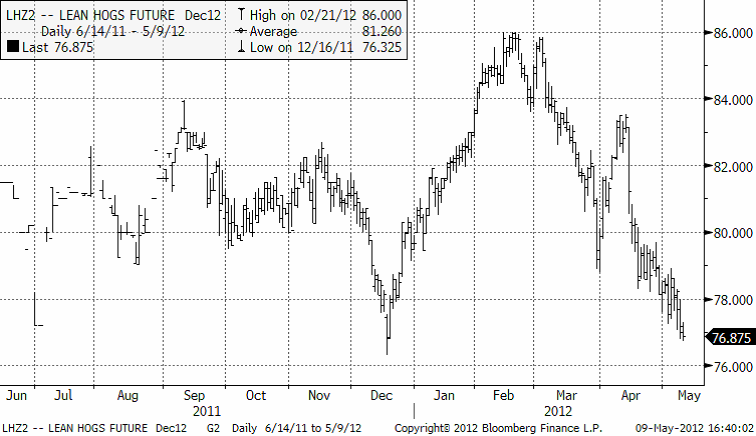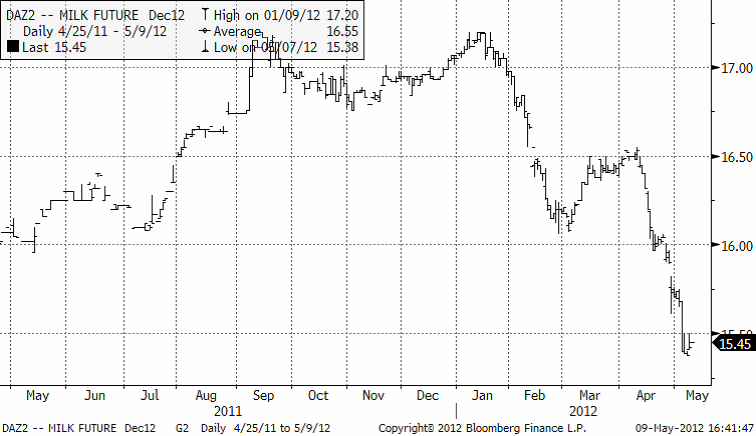Analys
SEB – Jordbruksprodukter, vecka 19 2012
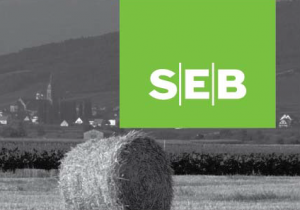 Inledning
Inledning
Efter helgens val i Grekland och Frankrike har förväntningarna på efterfrågan av råvaror minskat. Vi har sett prisfall på allt från olja till spannmål. Lite senare idag, klockan 14:30 publicerar USDA World Agricultural Supply and Demand Estimates (WASDE). Vi fokuserar därför på förväntningarna inför den rapporten i det här veckobrevet.
Som vi skrev om i förra veckobrevet kommer CME att utöka öppettiderna för handel i spannmåls-och oljeväxtterminer och optioner. CME har dock reviderat startdatumet för detta från den 14 maj till den 21 maj 2012. I samband med detta kommer också Kansas City Board of Trade (KCBOT) att utöka den elektroniska handeln i terminer och optioner för sitt flaggskepp HRWW (hard red winter wheat) och även Minneapolis Grain Exchange (MGEX) kommer att utöka handeln för alla sina terminer och optioner, inklusive HRSW (hard red spring wheat) med samma öppettider som CBOT (söndag till måndag från 17:00 till 16:00 och under måndag till fredag från 18:00 till 16:00).
Inför WASDE-rapporten
Nedan ser vi marknadens förväntningar inför dagens WASDE-rapport.
2012 US wheat production estimates
- All wheat production average estimate 2.196 BB vs. 1.99 BB in 2011
- All winter wheat production average estimate 1.634 BB vs. 1.494 BB in 2011
- Hard red winter wheat production average estimate .990 BB vs. .780 BB in 2011
- Soft red winter wheat production average estimate .413 BB vs. .458 BB in 2011
- White winter wheat production average estimate .231 BB vs. .256 BB in 2011
11/12 US ending stocks estimates
- Corn average estimate .758 BB vs. April report of .801 BB and vs. 1.128 BB in ‘10/11
- Beans average estimate .221 BB vs. April report of .250 BB and vs. .215 BB in ‘10/11
- Wheat average estimate .781 BB vs. April report of .793 BB and vs. .862 BB in ‘10/11
12/13 US ending stocks estimates
- Corn average estimate 1.704 BB
- Beans average estimate .170 BB
- Wheat average estimate .805 BB
11/12 global ending stocks estimates
- Corn average estimated 122.036 MT vs. April report of 122.71 MT
- Beans average estimate 53.304 MT vs. April report of 55.52 MT
- Wheat average estimate 205.402 vs. April report of 206.27 MT
12/13 global ending stocks estimates
- Corn average estimate 136.822 MT
- Beans average estimate 59.335 MT
- Wheat average estimate 195.571 MT
South American ‘11/12 crop production estimates
- ‘11/12 Argentine corn crop average estimate 20.7 MMT vs. April report of 21.5 MMT and vs. 23.8 M a year ago
- ‘11/12 Argentine bean crop average estimate 42.0 MMT vs. April report of 45.0 MMT and vs. 49.0 M a year ago
- ‘11/12 Brazilian corn crop average estimate 62.7 MMT vs. April report of 62.0 MMT and vs. 57.5 M a year ago
- ‘11/12 Brazilian bean crop average estimate 65.5 MMT vs. April report of 66.0 MMT and vs. 75.5 M a year ago
Odlingsväder
Southern Oscillation Index, ett mått på intensiteten i graden av La Niña eller El Niño, har plötsligt svängt upp ganska kraftigt. Senaste indexnivån är +1.7. En nivå mellan +7 och -7 indikerar neutrala ENSO-förhållanden. Det är alltså fortfarande neutrala förhållanden, med ett SOI på +1.7.
Till skillnad från “väder” går det ganska bra att göra tillförlitliga prognoser på ENSO ungefär 6 månader fram i tiden. Nedan ser vi australiensarnas ensembleprognos från den 1 maj och framåt.
Det som prognosticeras är alltså, alltjämt, El Niño-förhållanden under våren på södra halvklotet. Som vi skrivit förut, och som är värt att påminna nytillkomna läsare om, är att detta innebär mycket gott (fuktigt) väder i Sydamerika, världens nya kornbod.
Vete
Matifvetet med novemberleverans bröt slutligen 200 euro och föll abrupt efter det. I skrivande stund ligger priset på 197 euro. Nu är 200 euro ett motstånd. Många skulle säkert vilja sälja på den nivån, om priset bara gick upp dit igen. Stöd finns på 190 euro. Det historiska mönstret känns igen, och om marknaden beter sig som ”förr” borde priset gå ner till 190. Vid WASDE-rapporter tenderar marknaden att röra sig lite mer och kan röra sig ner till 190 om det vill sig illa.
Nedan ser vi Chicagovetet med leverans i december. Stödet på 650 cent håller ännu emot, även om priset faktiskt gått under.
Nedan ser vi hur terminspriserna på Matif och Chicago förändrats den senaste veckan. En stor väntad skörd har ökat contangot i Chicago. November på Matif har handlats ner och längre löptider på terminerna också. Som vi skriver lite längre fram i det här avsnittet om vete, har t ex franskt vete på fälten klassats upp och är i ganska gott skick trots kylan och torkan i vinter. Maj på Matif är i stort sett en avslutad marknad.
Crop condition för höstvetet i USA, som rapporterades i måndags kväll klockan 22, ligger på 63% good / excellent och det är 1% lägre än förra veckan. Ratings över 60% har (nästan) alltid lett fram till stora skördar.
Informa’s senaste prognos för den globala vete produktionen ligger nu på 679.41 mt. Förra månaden estimerade de en minskning till 679.65 mt från prognosen på 696.09 mt ett år tidigare. I sin senaste rapport skriver FAO att den globala veteproduktionen under 2012/13 beräknas uppgå till 675.1 mt, en nedjustering med 15 mt från deras första prognos i mars och ned 3.6 procent från förra året, men fortfarande väl över genomsnittet för de senaste fem åren.
FAO estimerar EU:s veteproduktion, världens största, till 135 mt vilket är linje med prognoser från andra analytiker under förra månaden. Även om sådd areal uppskattas ha ökat något så förväntas den stränga vintern orsaka större bortfall än normalt i många delar.
 Lägre produktion förväntas också i Marocko till följd av torka och utsikterna för sådd av vårgrödor i Centralasien har också försämrats pga av en långvarig torka. I USA däremot bekräftas en stark återhämtning från 2011 och utifrån ett antagande om normala säsongsförhållanden fram till skörd beräknas den sammanlagda veteskörden att uppgå till 59 mt. Produktionen i Ryssland visar på en marginell ökning och justeras upp med ca 1 procent till 56.8 mt. I Ukraina däremot förväntas en kraftig minskning i produktionen till följd av de ogynnsamma väderförhållanden som drabbat landet under hösten och vintern. Produktionen beräknas till 14 mt, ett fall med nästan 40 procent från 2011 års enorma skörd och väl under genomsnittet för de senaste fem åren. Även produktionen i Kazakstan justeras ned kraftigt. I Asien justeras produktionen för Kina och Pakistan ned något, utifrån en återgång till mer normala avkastningar jämfört med förra årets rekordskördar, medan prognosen för Indien justeras upp till rekord nivån 88.3 mt bl.a till följd av god vattentillgång och gödningsmedel. Indiens jordbruksminister lägger dock ribban något högre och estimerar landets veteproduktion till 90.23 mt. För att frigöra utrymme inför den kommande skörden ser Indien över möjligheten att exportera så mycket som 10 mt vete från statliga lager, och på listan över potentiella marknader finns sanktionsdrabbade Iran somnyligen vänt sig till Australien för att säkerställa landets behov av spannmål.
Lägre produktion förväntas också i Marocko till följd av torka och utsikterna för sådd av vårgrödor i Centralasien har också försämrats pga av en långvarig torka. I USA däremot bekräftas en stark återhämtning från 2011 och utifrån ett antagande om normala säsongsförhållanden fram till skörd beräknas den sammanlagda veteskörden att uppgå till 59 mt. Produktionen i Ryssland visar på en marginell ökning och justeras upp med ca 1 procent till 56.8 mt. I Ukraina däremot förväntas en kraftig minskning i produktionen till följd av de ogynnsamma väderförhållanden som drabbat landet under hösten och vintern. Produktionen beräknas till 14 mt, ett fall med nästan 40 procent från 2011 års enorma skörd och väl under genomsnittet för de senaste fem åren. Även produktionen i Kazakstan justeras ned kraftigt. I Asien justeras produktionen för Kina och Pakistan ned något, utifrån en återgång till mer normala avkastningar jämfört med förra årets rekordskördar, medan prognosen för Indien justeras upp till rekord nivån 88.3 mt bl.a till följd av god vattentillgång och gödningsmedel. Indiens jordbruksminister lägger dock ribban något högre och estimerar landets veteproduktion till 90.23 mt. För att frigöra utrymme inför den kommande skörden ser Indien över möjligheten att exportera så mycket som 10 mt vete från statliga lager, och på listan över potentiella marknader finns sanktionsdrabbade Iran somnyligen vänt sig till Australien för att säkerställa landets behov av spannmål.
I Australien visar tidiga indikationer på en minskad produktion av vete, dels genom en återgång till en mer normal avkastning men också för att lantbrukare väljer att så andra grödor till följd av högre, attraktiva priser. Samma sak i Argentina där lantbrukare förväntas öka produktionen av korn på bekostnad av vete.
Den första prognosen för den globala handeln (export) med vete under 2012/13 (juli/juni) beräknas uppgå till 135 mt, en minskning med 1.7 mt från 2011/12 och 4.6 mt ner från rekordnivån på 139.7 mt under 2008/09. En förväntad nedgång i import av vete speglar främst mindre inköp från flera asiatiska länder.
Efter en stark tillväxt i förbrukningen av vete under 2011/12, framförallt drivet av en exceptionell ökning av vete som foder, så beräknas konsumtionen troligen att minska något till 686 mt under 2012/13, vilket dock fortfarande överskrider trenden för de senaste 10 åren.
Prognosen för globala vetelager är en minskning med 6.5 procent eller 12.5 mt, för att slutligen nå 183 mt i slutet av säsongen 2013. De största minskningarna beräknas för Kina (-5 mt), Ukraina (-3.6 mt), Ryssland (-3.2 mt), Australien (-900 000 t), Kazakstan (-700 000 t) och Marocko (-700 000 t). De länder där lagren beräknas öka är bl.a USA (+1.9 mt), Indien (+1 mt) och Brasilien (+600 000 t).
Det franska vetet klassat som ”bra” (bonnes) eller ”utmärkt” (très bonnes) har ökat till 65% från 63% veckan innan enligt FranceAgriMer, och grödorna har fått god hjälp av det regn som har fallit under april. Siffrorna nedan visar genomsnittet för de 8 regioner som står för 64 procent av den franska vete produktionen. I Alsace-regionen, där grödor skadades av den extrema kylan i februari, har de grödor som klassas som ”bra” eller ”utmärkt” ökat till 44 procent från 40 procent veckan innan. I Centre, landets största veteproducerande region, matchade 64 procent de två bästa klassificeringarna, upp från 61 procent. Det franska durumvetet klassat som ”bra eller ”utmärkt” har ökat till 49% från 46 procent veckan innan.
Kansas ser ut att gå emot en rekordskörd då den 3 dagar långa inspektionen (crop tour) av Kansas höstvete nu är klar. Grödorna ser lovande ut enligt observatörerna och förväntas ge en genomsnittlig avkastning på 49.1 bushels per acre, en uppgång med nästan 3 procent från den tidigare rekordprognosen från 2005 enligt WQC. Siffran som baseras på en undersökning av 608 områden under tre dagar, är högre än förra årets genomsnittliga estimat på 37.4 bushels per acre som baserades på 561 områden. Genomsnittet under de senaste 3 åren ligger på 39.6 bushels per acre. Trots en skakig start på säsongen har en varm vår och gynnsamma väderförhållanden i allmänhet fått Kansas vete att utvecklas snabbare än normalt i år, och även fast de inspekterade grödorna är i relativt gott skick generellt och i ett långt framskridet utvecklingsstadium så varnar ändå vissa för att estimatet på 49.1 är lite väl högt. En prognos baserad på 49.1 bushels per acre skulle resultera i en produktion på 403.9 miljoner bushels, vilket kan jämföras med produktionen på 276.5 miljoner bushels under 2011 enligt USDA.
Polen, en av EU:s största spannmålsproducenter, har drabbats hårt av de ogynnsamma väderförhållandena under vintern. Det uppges nu att så mycket som 29 procent av landets höstgrödor har förstörts och man räknar med att mer än 1.3 miljoner hektar (av ca 4.5 miljoner sådd hektar) kommer att behöva plöjas och sås om igen. Under 2011 producerade landet 26.8 mt spannmål.
Trots en liten ökning av sådd areal för höstgrödor i Spanien, enligt officiell statistik, kommer produktionen troligtvis att sjunka med ca 25 procent jämfört med föregående säsong. Den senaste tidens regn har varit till hjälp för grödorna, men långt ifrån tillräckligt för att kompensera bristen på regn under vinter och tidig vår, särskild i de södra och östra spannmålsproducerande regionerna, där grödorna skördas tidigare. Väderförhållanden i maj kommer att vara avgörande för avkastningen i de områden där grödorna fortfarande har potential att återhämta sig.
Med ett antagande om genomsnittlig konsumtion i landet, förväntas den lägre skörden sannolikt resultera i att landets import av spannmål, Spanien är EU’s största importör, kan komma att överstiga 11 mt under 2012/13.
En lägre skörd av durumvete i Andalusien har ännu inte bekräftats officiellt av landets jordbruksminister, men det finns indikationer på att den totala produktionen av durumvete kan komma att bli 30 procent lägre än föregående säsong.
Ministeriets produktionssiffror nedan baseras på data från februari, då nederbörden i de flesta regioner var praktiskt taget noll. Så även om det kommer att bli en betydande nedgång i spannmålsproduktionen så borde vete och korn fortfarande kunna återhämta sig något i de områden där skörden av dessa grödor sker senare. Spaniens spannmålsproduktion enligt officiell statistik från februari 2012:
Argentinas veteexport för 2011/12 väntas uppgå till 10 mt som ett resultat av förväntade lägre utgående lager enligt FAO. Trots utmärkta odlingsförhållanden, ser det ut som många av Argentinas lantbrukare avstår från att så höstvete eftersom statens inblandning i marknaden har drivit priserna så lågt att lantbrukarna inte tycker det är värt tiden de lägger ner. Sådden av 2012/13 års vete förväntas sjunka med 15 procent på året då låga priser leder till att lantbrukare föredrar andra alternativa höstgrödor. Argentinska lantbrukare sådde 4.6 miljoner hektar vete under säsongen 2011/12, en minskning från 5.9 miljoner hektar under säsongen 2007/08, innan regeringen började driva igenom snäva export restriktioner. Exportpriserna på argentinskt vete i början av maj var 30 procent lägre än vid samma tidpunkt förra året. Argentina har alltid haft en liten skatt på exporten, men på senare år har den exploderat som ett resultat av att regeringen motiverade dessa höjningar med att de inte kunde lita på att lantbrukarna skulle vara ärliga nog att betala sin del av inkomstskatten.
Lantbrukare i Buenos Aires-provinsen planerar att stoppa all försäljning av spannmål och boskap under fyra dagar med start på torsdag för att protestera mot regeringsplaner på höjda skatter på markägande. Även arbetare vid Argentinas ledande exporthamnar planerar att påbörja strejk på torsdag.
Celeres uppskattar Brasiliens veteproduktion för 2011/12 till 5.45 mt jämfört med 5.66 mt under 2010/11. Brasilien med sina nästan 200 miljoner invånare, importerar mycket vete från Argentina.
Maltkorn
Novemberkontraktet på maltkorn har fallit ner till stödnivån 220 euro per ton.
Enligt FAO förväntas den globala produktionen av korn under 2012 att vara i stort sett oförändrad på ca 136 mt. Bland de stora kornproducerande länderna, kan betydande minskningar förväntas i Nordafrika och OSS Asien men som till stor del kompenseras av ökad produktion i EU och USA. I EU förväntas den totala arealen för korn att öka jämfört med 2011 och beror till stor del på en ökning av vårgrödor, speciellt där höstgrödor har blivit skadade och kommer att ersättas. Under antagandet om normala förhållanden, beräknas EU’s produktion att öka med ca 4 procent till 54 mt. I USA och Kanada förväntas också ökningar av sådd areal för korn och därmed större skördar. Däremot förväntas en stor nedgång i Marockos produktion av korn i år till följd av torka.
Enligt FranceAgriMer är andelen franskt höstkorn klassat som ”bra” (bonnes) eller ”utmärkt” (très bonnes) oförändrad från veckan innan på 48 respektive 10 procent, baserat på förhållanden i sju regioner som representerar 56 procent av landets produktion.
Vad gäller franskt vårkorn ökade klassificeringen ”utmärkt” till 19 procent från 18 procent veckan innan, medan grödorna som klassificeras som ”bra” sjönk med 1 procent till 60 procent. Siffrorna baseras på data från fem regioner som i genomsnitt odlar 47 procent av landets vårkorn. Grödorna i Lorraine fortsätter att förbättras, och vårkorn där som klassificeras som ”utmärkt” uppgår nu till 24 procent jämfört med 19 procent veckan innan.
Produktionen av korn i Argentina under 2011/12 förväntas uppgå till 4.4 mt till följd av ökad skördad areal och ger utrymme för ytterligare export, som nu estimeras till 3.4 mt. Över 65 procent kommer att vara foderkorn. Det finns tillräckligt med utsäde för att kunna utöka odlad areal till 1.5 miljoner hektar för säsongen 2012/13.
Potatis
Potatispriset för leverans nästa år, har fortsatt att stiga. Från förra veckans 14.70 euro noteras i skrivande stund 15.20. Trenden är positiv och tycks vara stark. Det verkar som om priset kan gå högre, med andra ord.
Majs
Priset på decembermajs har fortsatt att bryta tekniska stödnivåer och det råder inget tvivel om att trenden är nedåtriktad.
Den 27 april var sådden till 53% klar, vilket är en ökning från 28% för en vecka sedan.
Den globala majsproduktionen under 2012 beräknas uppgå till ca 916 mt, en uppgång med 4.1 procent från 2011. I USA fick odlingssäsongen en tidig start i de södra staterna med gynnsamma förhållanden, och under antagandet att amerikanska lantbrukares intentioner gällande planerad sådd visar sig stämma (38.8 miljoner hektar) i kombination med normala förhållanden resten av säsongen, så beräknas USA’s produktion av majs preliminärt uppgå till rekordhöga 345 mt.
I Kina, världens näst största majsproducent, förväntas produktionen ligga nära förra årets rekord på ca 190 mt.
Arealen för majs i EU förväntas öka i år, kanske mer än väntat, med tanke på de senaste rapporterna om att större än förväntade områden med höstgrödor har förstörts och kommer att ersättas med vårgrödor. Men med en återgång till en mer genomsnittlig avkastning efter förra årets höga nivåer, så beräknas produktion minska med ca 4 procent till 64 mt. På det södra halvklotet är skörden i stort sett klar eller i slutfasen. Brasiliens produktion beräknas till rekordhöga 66 mt, en ökning med 17 procent från 2011, medan produktionen i Argentina beräknas till 20.3 mt på grund av de negativa effekterna från den långvariga torkan.
Argentinas produktion av majs för 2011/12 förväntas uppgå till 20.3 mt enligt FAO, vilket är 11 procent ned från rekordnivån 2011, men på den här nivån ligger majsproduktionen ändå nära genomsnittet för de senaste fem åren. Skörden pågår nu i de största majsproducerande områdena Buenos Aires, Cordoba och Santa Fe. Även om mindre än 50 procent av skörden är avklarad, (lantbrukarna skördar nu istället sojabönor för att sedan återgå till majsskörden), så är den genomsnittliga avkastningen för majs låg främst beroende på den svåra torkan och höga temperaturer under sommaren. Majs som såddes senare, och utgör ca 25 procent av totalen, är i utmärkt skick med en förväntad avkastning på 8-9 ton per hektar. De flesta lokala prognoser för majsproduktionen ligger i intervallet 19-22 mt.
Exporten av majs under 2012/13 (mars/februari) förväntas preliminärt att uppgå till 14 mt, en nedgång med 3 procent från föregående säsong. Trots en relativt stor estimerad minskning av produktionen under 2012 förväntas exporten endast minska marginellt på grund av höga lager från förra årets rekordskörd.
Cordonnier estimerar Argentinas majsproduktion för 2011/12 till 19.0 mt, oförändrad från tidigare prognos, och skörden rapporteras vara avklarad till 47%. Celeres estimerar Brasiliens majsproduktion för 2011/12 till 65 mt, jämfört med tidigare prognos på 60.7 mt, medan Safras e Mercado uppskattar produktionen till 66.57 mt. Cordonnier’s prognos ligger på 62 mt, en ökning med 1 mt från det tidigare estimatet på 61 mt.
Sojabönor
Marknaden bröt stödet, som låg på 1328 cent i novemberkontraktet. Därmed är den stigande trenden bruten. Det innebär inte att vi nu har en fallande trend. Däremot ska man nog inte hoppas på att kunna sälja på 1400 cent på ett tag.
Sådden går fort framåt i USA. Den 20 april var 24% sått i USA. Förra veckan var det 12%. Vi ser noteringarna i diagrammet nedan som med blå kvadrater. Hittills ser det tidigt och bra ut.
Den globala sojabönsproduktionen för 2011/12 förväntas minska med nästan 10 procent enligt FAO, vilket är ett av de största minskningarna sedan året innan. Bidragande faktorer till detta är bl.a en minskning med 8 procent i USA’s produktion, på grund av lägre sådd areal och dålig avkastning, och de senaste estimaten för Sydamerikas produktion som visar på en nedgång YoY med mer än 14 procent. Efter att regionens tre största producenter, Brasilien, Argentina och Paraguay ökade arealen för sojabönor, orsakade väderfenomenet La Niña en exceptionell torka och en minskad avkastning som följd. Skördebortfallet i de tre länderna uppskattas till 13, 10 och 56 procent respektive. Sammanlagt förväntas de tre länderna att producera 26 mt mindre (11%) sojabönor än förra säsongen. Även Kina får antagligen se en nedgång i sin sojabönsproduktion, främst som en följd av minskad areal. Den enda viktiga sojabönsproducenten som rapporterar en ökning i produktionen är därmed Indien.
Rekordhöga sojabönspriser uppmuntrar lantbrukare i Brasilien att sälja sin nuvarande produktion av sojabönor, och sälja den förväntade produktionen för 2012/13 på termin, samt köpa sitt behov av utsäde för kommande säsong tidigare än normalt. Även om priset på utsäde har stigit med 30 procent jämfört med förra året är några av de mest populära sorterna redan slutsålda även fast sådden inte startar förrän om minst ytterligare fem månader.
En av orsakerna till de tidiga inköpen är det faktum att producenter också förväntar sig att priserna på utsäde kommer att fortsätta stiga på grund av den starka efterfrågan. Enligt Abrasem, så säljs sojabönssorter nu för R$ 2.00-3.00 per kilo jämfört med R$ 1.40-2.00 per kilo förra säsongen. En reais kostar ca 3,50 kr. Coamo-kooperativet i västra Parana börjar oftast sitt årliga skördeprogram i juni eller juli, då deras medlemmar kan köpa insatsvaror som behövs för nästa odlingssäsong. I år har dock programmet inletts redan i slutet av april och kooperativet räknar med att under början på maj så kommer lantbrukare redan att ha köpt 85-90 procent av det utsäde som behövs för 2012/13 års grödor.
Buenos Aires Grain Exchange (BAGE) sänker återigen sin prognos för Argentinas produktion av sojabönor 2011/12 och denna gång justerar de ned siffran med ytterligare 2 mt till 41 mt vilket är 17 procent lägre än förra årets skörd på 49.2 mt. Avkastningen beräknas ligga i intervallet 2.6-2.8 ton per hektar, med två tredjedelar av skörden avklarad, jämfört med förväntningarna på 2.9-3.1 ton per hektar.
Även OilWorld sänker sin prognos för Argentinas produktion med 1.5 mt till 41 mt. Cordonnier estimerar Argentinas produktion till 40.0 mt, oförändrad från tidigare estimat, men säger att produktionen kan komma att bli så låg som 37.0 mt. Enligt uppgift från dem är skörden avklarad till 65 procent.
Conab kommer med sin prognos på torsdag. Celeres estimerar Brasiliens sojabönsproduktion för 2011/12 till 64.95 mt, jämfört med tidigare estimat på 67.9 mt, och uppger att 98 procent av skörden är avklarad och att 80 procent av skörden redan är såld. Safras e Mercado rapporterar att per den 4 maj så var 97 procent av skörden avklarad jämfört med 98 procent för ett år sedan och jämfört med det femåriga genomsnittet på 95 procent. Produktionen beräknas uppgå till 66.82 mt, ned 2.1 procent från tidigare estimat. Cordonnier estimerar Brasiliens produktion av sojabönor till 65.0 mt, oförändrat från tidigare estimat. Informas första prognos för sojabönsproduktionen under 2012/13 visar på 80.5 mt för Brasilien och 60 mt för Argentina.
Raps
Priset på novemberterminen som stabiliserat sig strax under 480 euro per ton, följde med sojabönorna ner mot 460-euro-nivån. Liksom i fallet med sojabönor ser vi att den starka uppgångsfasen är bruten, ur ett tekniskt analys-perspektiv. Nästa tekniska stödnivå på nedsidan finns vid 440 euro per ton och detta stöd torde vara ganska starkt.
FAO skriver i sin senaste rapport att den globala produktionen av raps förväntas sjunka något. Minskad produktion i EU och Indien har bekräftats, medan estimaten för produktionen i Kanada och Australien har justerats upp avsevärt jämfört med de ursprungliga prognoserna.
Gris
Den här veckan riktar vi in oss på decemberkontraktet på Lean Hogs. Priset har fallit krafit sedan toppnoteringen i februari på 86 cent per pund. Nu ligger priset på 76.9 cent. Det är nära bottennoteringen från den 16 december på 76.3 cent. Bottennoteringen utgör ett stöd, eftersom priset vänt där en gång tidigare. Det skulle alltså kunna komma in köpare på den är nivån just av den anledningen.
Mjölk
Mjölkpriset (decemberleverans) har fallit från 15.68 cent förra veckan till 15.45 cent i skrivande stund. Från toppnoteringen 17.20 cent har fallet gått fort. Priset ligger nu på den lägsta nivån det senaste året.
[box]SEB Veckobrev Veckans råvarukommentar är producerat av SEB Merchant Banking och publiceras i samarbete och med tillstånd på Råvarumarknaden.se[/box]
Disclaimer
The information in this document has been compiled by SEB Merchant Banking, a division within Skandinaviska Enskilda Banken AB (publ) (“SEB”).
Opinions contained in this report represent the bank’s present opinion only and are subject to change without notice. All information contained in this report has been compiled in good faith from sources believed to be reliable. However, no representation or warranty, expressed or implied, is made with respect to the completeness or accuracy of its contents and the information is not to be relied upon as authoritative. Anyone considering taking actions based upon the content of this document is urged to base his or her investment decisions upon such investigations as he or she deems necessary. This document is being provided as information only, and no specific actions are being solicited as a result of it; to the extent permitted by law, no liability whatsoever is accepted for any direct or consequential loss arising from use of this document or its contents.
About SEB
SEB is a public company incorporated in Stockholm, Sweden, with limited liability. It is a participant at major Nordic and other European Regulated Markets and Multilateral Trading Facilities (as well as some non-European equivalent markets) for trading in financial instruments, such as markets operated by NASDAQ OMX, NYSE Euronext, London Stock Exchange, Deutsche Börse, Swiss Exchanges, Turquoise and Chi-X. SEB is authorized and regulated by Finansinspektionen in Sweden; it is authorized and subject to limited regulation by the Financial Services Authority for the conduct of designated investment business in the UK, and is subject to the provisions of relevant regulators in all other jurisdictions where SEB conducts operations. SEB Merchant Banking. All rights reserved.
Analys
Brent crude inching higher on optimism that US inflationary pressures are fading


Brent crude price inching higher on optimistic that US inflationary pressures are fading. Brent crude closed up 1.1 USD/b ydy to a close of USD 86.39/b which was the highest close since the end of April. This morning it is trading up another half percent to USD 86.9/b along with comparable gains in industrial metals and Asian equities. At 14:30 CET the US will publish its preferred inflation gauge, the PCE figure. Recent data showed softer US personal spending in Q1. Expectations are now high that the PCE inflation number for May will show fading inflationary pressures in the US economy thus lifting the probability for rate cuts later this year which of course is positive for the economy and markets in general and thus positive for oil demand and oil prices. Hopes are high for sure.
Brent crude is trading at the highest since the end of April
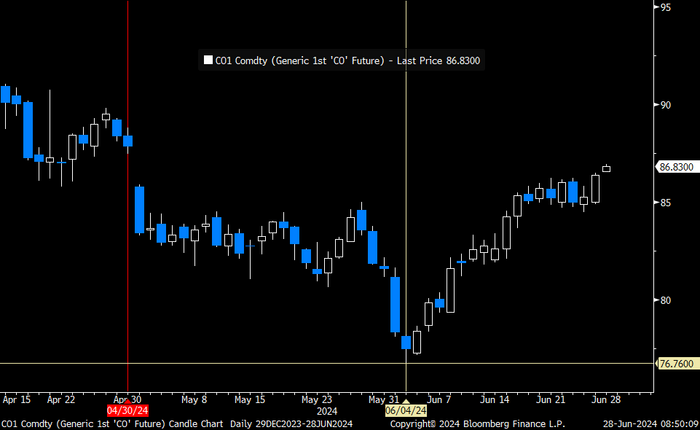
The rally in Brent crude since early June is counter to rising US oil inventories and as such a bit puzzling to the market.
US commercial crude and oil product stocks excluding SPR.

Actual US crude oil production data for April will be published later today. Zero growth in April is likely. Later today the US EIA will publish actual production data for US crude and liquids production for April. Estimates based on US DPR and DUC data indicates that there will indeed be zero growth in US crude oil production MoM in April. This will likely driving home the message that there is no growth in US crude oil production despite a Brent crude oil price of USD 83/b over the past 12 mths. The extension of this is of course rising expectations that there will be no growth in US crude oil production for the coming 12 months either as long as Brent crude hoovers around USD 85/b.
US production breaking a pattern since Jan 2014. No growth at USD 83/b. What stands out when graphing crude oil prices versus growth/decline in US crude oil production is that since January 2014 we have not seen a single month that US crude oil production is steady state or declining when the Brent crude oil price has been averaging USD 70.5/b or higher.
US Senate looking into the possibility that US shale oil producers are now colluding by holding back on investments, thus helping to keep prices leveled around USD 85/b.
Brent crude 12mth rolling average price vs 4mth/4mth change in US crude oil production. Scatter plot of data starting Jan 2014. Large red dot is if there is no change in US crude oil production from March to April. Orange dots are data since Jan 2023. The dot with ”-1.3%” is the March data point.
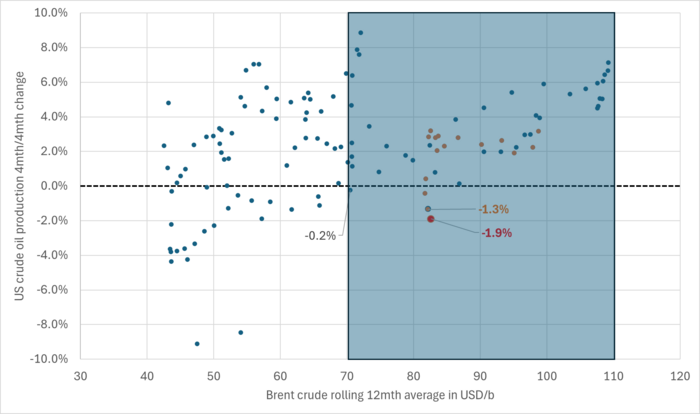
Brent crude 12mth rolling average price vs 4mth/4mth change in US crude oil production. Data starting Jan 2014. The last data point is if there is no change in US crude oil production from March to April.
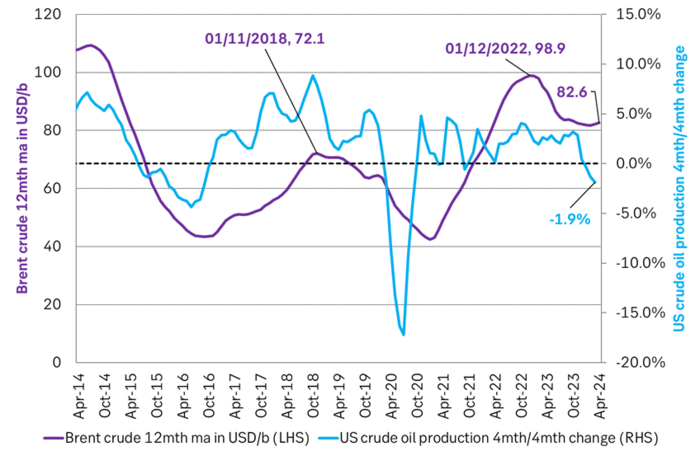
Analys
Price forecast update: Weaker green forces in the EU Parliament implies softer EUA prices


We reduce our forecast for EUA prices to 2030 by 10% to reflect the weakened green political agenda in the EU Parliament following the election for the Parliament on 6-9 June. The upcoming election in France on 7 July is an additional risk to the political stability of EU and thus in part also to the solidity of the blocks green agenda. Environmental targets for 2035 and 2040 are most at risk of being weakened on the margin. EUA prices for the coming years to 2030 relate to post-2030 EUA prices through the bankability mechanism. Lower post-2030 climate ambitions and lower post-2030 EUA prices thus have a bearish impact on EUA prices running up to 2030. Actual softening of post-2030 climate ambitions by the EU Parliament have yet to materialize. But when/if they do, a more specific analysis for the consequences for prices can be carried out.
EUA prices broke with its relationship with nat gas prices following the EU Parliament election. The EUA price has dutifully followed the TTF nat gas price higher since they both bottomed out on 23 Feb this year. The EUA front-month price bottomed out with a closing price of EUR 50.63/ton on 23 Feb. It then reached a recent peak of EUR 74.66/ton on 21 May as nat gas prices spiked. Strong relationship between EUA prices and nat gas prices all the way. Then came the EU Parliament election on 6-9 June. Since then the EUA price and TTF nat gas prices have started to depart. Bullish nat gas prices are no longer a simple predictor for bullish EUA prices.
The front-month EUA price vs the front-year TTF nat gas price. Hand in hand until the latest EU Parliament election. Then departing.
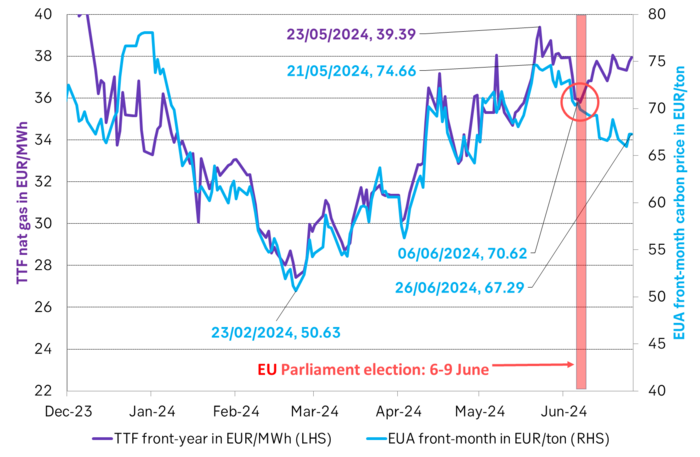
The EU Parliament election on 6-9 June was a big backlash for the Greens. The Greens experienced an euphoric victory in the 2019 election when they moved from 52 seats to 74 seats in the Parliament. Since then we have had an energy crisis with astronomic power and nat gas prices, rampant inflation and angry consumers being hurt by it all. In the recent election the Greens in the EU Parliament fell back to 53 seats. Close to where they were before 2019.
While green politics and CO2 prices may have gotten a lot of blame for the pain from energy prices over the latest 2-3 years, the explosion in nat gas prices are largely to blame. But German green policies to replace gas and oil heaters with heat pumps and new environmental regulations for EU farmers are also to blame for the recent pullback in green seats in the Parliament.
Green deal is still alive, but it may not be fully kicking any more. Existing Green laws may be hard to undo, but targets for 2035 and 2040 will be decided upon over the coming five years and will likely be weakened.
At heart the EU ETS system is a political system. As such the EUA price is a politically set price. It rests on the political consensus for environmental priorities on aggregate in EU.
The changes to the EU Parliament will likely weaken post-2030 environmental targets. The changes to the EU Parliament may not change the supply/demand balance for EUAs from now to 2030. But it will likely weaken post-2030 environmental targets and and thus projected EU ETS balances and EUA prices post-2030. And through the bankability mechanism this will necessarily impact EUA prices for the years from now to 2030.
Weaker post-2030 ambitions, targets and prices implies weaker EUA prices to 2030. EUA prices are ”bankable”. You can buy them today and hold on to them and sell them in 2030 or 2035. The value of an EUA today fundamentally rests on expected EUA prices for 2030/35. These again depends on EU green policies for the post 2030 period. Much of these policies will be ironed out and decided over the coming five years.
Weakening of post-2030 targets have yet to materialize. But just talking about it is a cold shower for EUAs. These likely coming weakenings in post-2030 environmental targets and how they will impact EUA prices post 2030 and thus EUA prices from now to 2030 are hard to quantify. But what is clear to say is that when politicians shift their priorities away from the environment and reduce their ambitions for environmental targets post-2030 it’s like a cold shower for EUA prices already today.
On top of this we now also have snap elections in the UK on 4 July and in France on 7 July with the latter having the potential to ”trigger the next euro crisis” according to Gideon Rachman in a recent article in FT.
What’s to be considered a fair outlook for EUA prices for the coming five years in this new political landscape with fundamentally changed political priorities remains to be settled. But that EUA price outlooks will be lowered versus previous forecasts is almost certain.
We reduce our EUA price forecast to 2030 by 10% to reflect the new political realities. To start with we reduce our EUA price outlook by 10% from 2025 to 2030 to reflect the weakened Green agenda in the EU parliament.
SEB’s EUA price forecast, BNEF price forecasts and current market prices in EUR/MWh
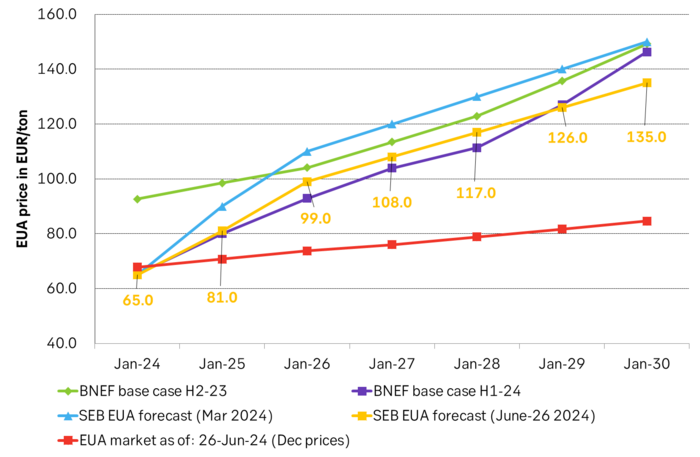
Analys
The most important data point in the global oil market will be published on Friday 28 June


US crude oil production has been booming for more than a decade. Interrupted by two setbacks in response to sharp price declines. The US boom has created large waves in the global oil market and made life very difficult for OPEC(+). Brent crude has not traded below USD 70/b since Dec-2021 and over the past year, it has averaged USD 84/b. US shale oil production would typically boom with such a price level historically. However, there has been zero growth in US crude oil production from Sep-2023 to Mar-2024. This may be partially due to a cold US winter, but something fundamentally seems to have changed. We recently visited a range of US E&P and oil services companies in Houston. The general view was that there would be zero growth in US crude oil production YoY to May 2025. If so and if it also is a general shift to sideways US crude oil production beyond that point, it will be a tremendous shift for the global oil market. It will massively improve the position of OPEC+. It will also sharply change our perception of the forever booming US shale oil supply. But ”the proof is in the pudding” and that is data. More specifically the US monthly, controlled oil production data is to be published on Friday 28 June.
The most important data point in the global oil market will be published on Friday 28 June. The US EIA will then publish its monthly revised and controlled oil production data for April. Following years of booming growth, the US crude oil production has now gone sideways from September 2023 to March 2024. Is this a temporary blip in the growth curve due to a hard and cold US winter or is it the early signs of a huge, fundamental shift where US crude oil production moves from a decade of booming growth to flat-lining horizontal production?
We recently visited a range of E&P and oil services companies in Houston. The general view there was that US crude oil production will be no higher in May 2025 than it is in May 2024. I.e. zero growth.
It may sound undramatic, but if it plays out it is a huge change for the global oil market. It will significantly strengthen the position of OPEC+ and its ability to steer the oil price to a suitable level of its choosing.
The data point on Friday will tell us more about whether the companies we met are correct in their assessment of non-growth in the coming 12 months or whether production growth will accelerate yet again following a slowdown during winter.
The US releases weekly estimates for its crude oil production but these are rough, temporary estimates. The market was fooled by these weekly numbers last year when the weekly numbers pointed to a steady production of around 12.2 m b/d from March to July while actual monthly data, with a substantial lag in publishing, showed that production was rising strongly.
The real data are the monthly, controlled data. These data will be the ”proof of the pudding” of whether US shale oil production now is about to shift from a decade of booming growth to instead flat-line sideways or whether it will drift gradually higher as projected by the US EIA in its latest Short-Term Energy Outlook.
US crude oil production given by weekly data and monthly data. Note that the monthly, controlled data comes with a significant lag. The market was thus navigating along the weekly data which showed ”sideways at 12.2 m b/d” for a significant period last year until actual data showed otherwise with a time-lag.
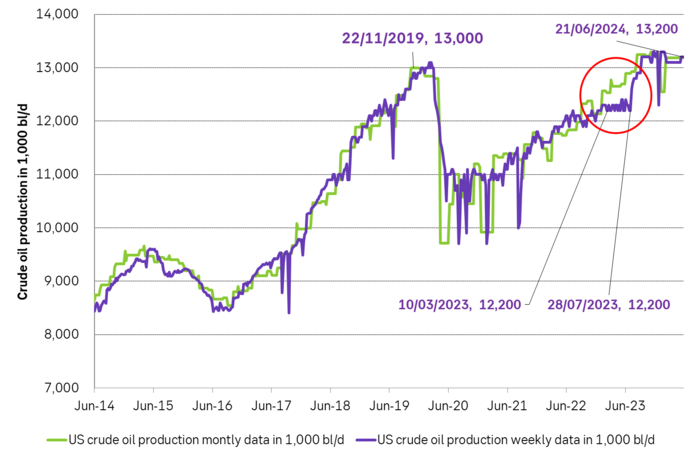
If we add in Natural Gas Liquids and zoom out to include history back to 2001 we see an almost uninterrupted boom in supply since Sep 2011 with a few setbacks. At first glance, this graph gives little support to a belief that US crude oil production now suddenly will go sideways. Simple extrapolation of the graph indicates growth, growth, growth.
US crude and liquids production has boomed since September 2011
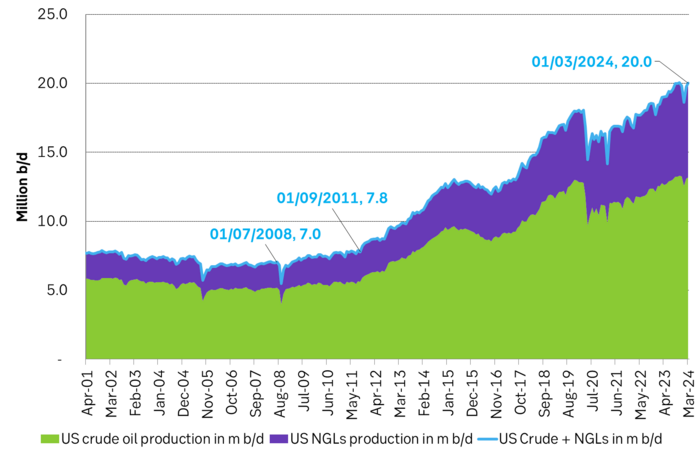
However. The latest actual data point for US crude oil production is for March with a reading of 13.18 m b/d. What stands out is that production then was still below the September level of 13.25 m b/d.
The world has gotten used to forever growing US crude oil production due to the US shale oil revolution, with shorter periods of sharp production declines as a result of sharp price declines.
But the Brent crude oil price hasn’t collapsed. Instead, it is trading solidly in the range of USD 70-80-90/b. The front-month Brent crude oil contract hasn’t closed below USD 70/b since December 2021.
Experiences from the last 15 years would imply wild production growth and activity in US shale oil production at current crude oil prices. But US crude oil production has now basically gone sideways to lower from September to March.
The big, big question is thus: Are we now witnessing the early innings of a big change in US shale oil production where we shift from booming growth to flat-lining of production?
If we zoom in we can see that US liquids production has flat-lined since September 2023. Is the flat-lining from Sep to Mar due to the cold winter so that we’ll see a revival into spring and summer or are we witnessing the early signs of a huge change in the global oil market where US crude oil production goes from booming growth to flat-line production.

The message from Houston was that there will be no growth in US crude oil production until May 2025. SEB recently visited oil and gas producers and services providers in Houston to take the pulse of the oil and gas business. Especially so the US shale oil and shale gas business. What we found was an unusually homogeneous view among the companies we met concerning both the state of the situation and the outlook. The sentiment was kind of peculiar. Everybody was making money and was kind of happy about that, but there was no enthusiasm as the growth and boom years were gone. The unanimous view was that US crude oil production would be no higher one year from now than it is today. I.e. flat-lining from here.
The arguments for flat-lining of US crude oil production here onward were many.
1) The shale oil business has ”grown up” and matured with a focus on profits rather than growth for the sake of growth.
2) Bankruptcies and M&As have consolidated the shale oil companies into larger, fewer public companies now accounting for up to 75% of total production. Investors in these companies have little interest/appetite for growth after having burned their fingers during a decade and a half of capital destruction. These investors may also be skeptical of the longevity of the US shale oil business. Better to fully utilize the current shale oil infrastructure steadily over the coming years and return profits to shareholders than to invest in yet more infrastructure capacity and growth.
3) The remaining 25% of shale oil producers which are in private hands have limited scope for growth as they lack pipeline capacity for bringing more crude oil from field to market. Associated nat gas production is also a problem/bottleneck as flaring is forbidden in many places and pipes to transport nat gas from field to market are limited.
4) The low-hanging fruits of volume productivity have been harvested. Drilling and fracking are now mostly running 24/7 and most new wells today are all ”long wells” of around 3 miles. So hard to shave off yet another day in terms of ”drilling yet faster” and the length of the wells has increasingly reached their natural optimal length.
5) The average ”rock quality” of wells drilled in the US in 2024 will be of slightly lower quality than in 2023 and 2025 will be slightly lower quality than 2024. That is not to say that the US, or more specifically the Permian basin, is quickly running out of shale oil resources. But this will be a slight headwind. There is also an increasing insight into the fact that US shale oil resources are indeed finite and that it is now time to harvest values over the coming 5-10 years. One company we met in Houston argued that US shale oil production would now move sideways for 6-7 years and then overall production decline would set in.
The US shale oil revolution can be divided into three main phases. Each phase is probably equally revolutionary as the other in terms of impact on the global oil market.
1) The boom phase. It started after 2008 but didn’t accelerate in force before the ”Arab Spring” erupted and drove the oil price to USD 110/b from 2011 to 2014. It was talked down time and time again, but it continued to boom and re-boom to the point that today it is almost impossible to envision that it won’t just continue to boom or at least grow forever.
2) The plateau phase. The low-hanging fruits of productivity growth have been harvested. The highest quality resources have been utilized. The halfway point of resources has been extracted. Consolidation, normalization, and maturity of the business has been reached. Production goes sideways.
3) The decline phase. Eventually, the resources will have been extracted to the point that production unavoidably starts to decline.
Moving from phase one to phase two may be almost as shocking for the oil market as the experience of phase 1. The discussions we had with oil producers and services companies in Houston may indicate that we may now be moving from phase one to phase two. That there will be zero shale oil production growth YoY in 2025 and that production then may go sideways for 6-7 years before phase three sets in.
US EIA June STEO report with EIA’s projection for US crude oil production to Dec-2025. Softer growth, but still growth.
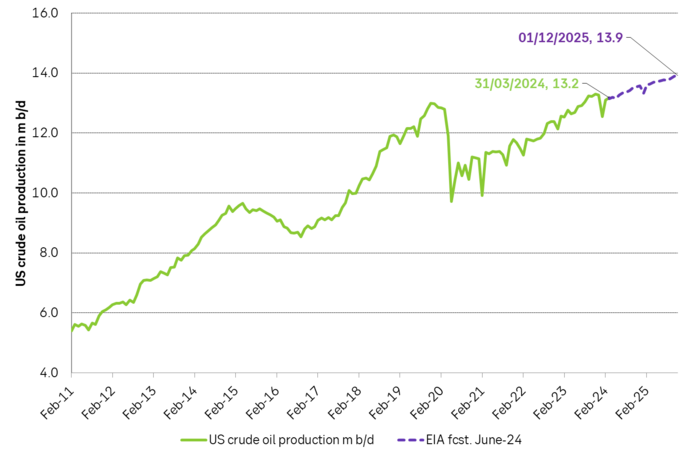
US EIA June STEO report with YoY outlook growth for 2025. Projects that US crude production will grow by 0.47 m b/d YoY in 2025 and that total liquids will grow by 720 k b/d YoY.
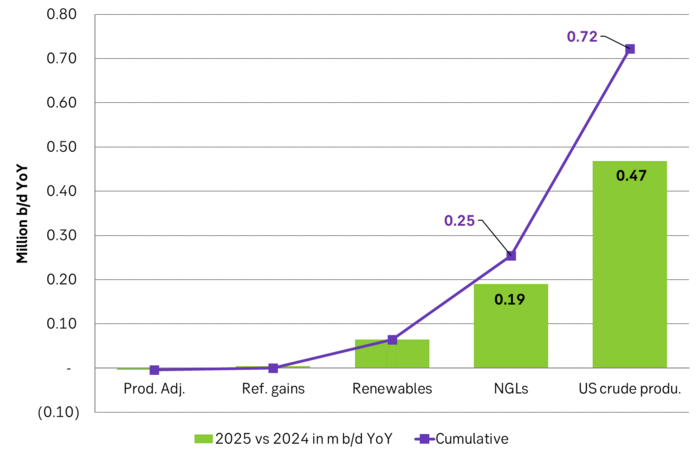
US EIA June STEO report with outlook for production growth by country in 2025. This shows how big the US production growth of 0.7 m b/d YoY really is compared to other producers around the world
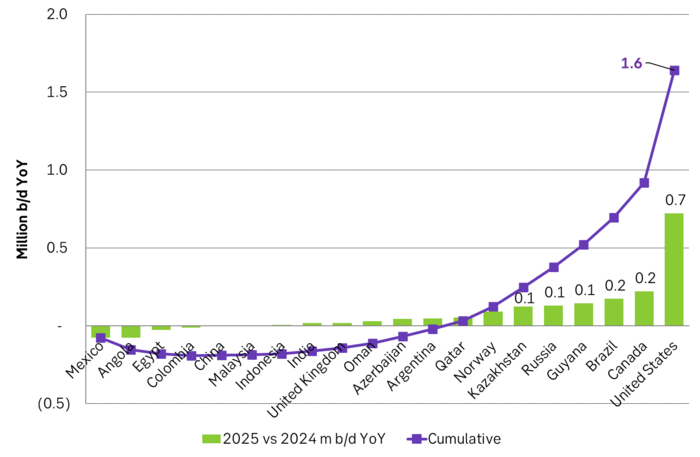
US EIA June STEO report with projected global growth in supply and demand YoY in 2025. Solid demand growth, but even strong supply growth with little room for OPEC+ to expand. Production growth by non-OPEC+ will basically cover global oil demand growth.
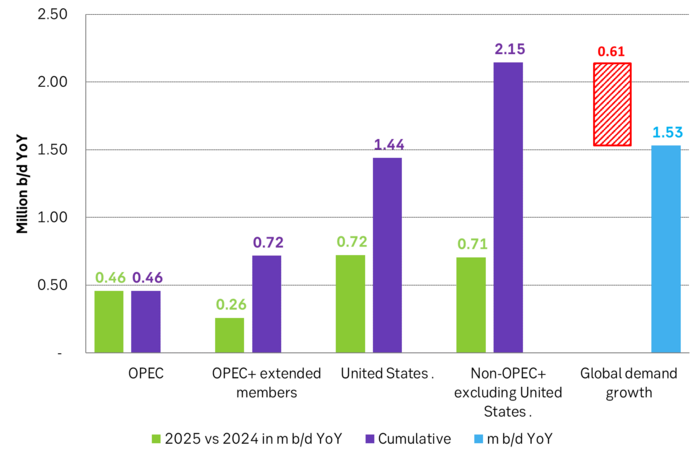
But if there instead is zero growth in US crude oil production in 2025 and the US liquids production only grows by 0.25 m b/d YoY due to NGLs and biofuels, then suddenly there is room for OPEC+ to put some of its current production cuts back into the market. Thus growth/no-growth in US shale oil production will be of huge importance for OPEC+ in 2025. If there is no growth in US shale oil then OPEC+ will have a much better position to control the oil price to where it wants it.
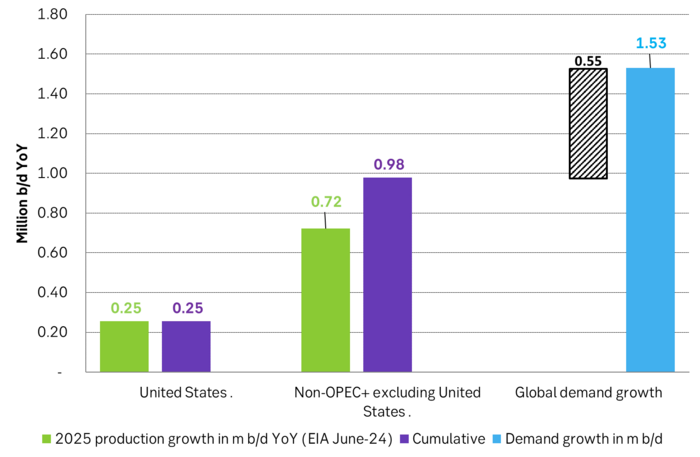
US crude oil production and drilling rig count
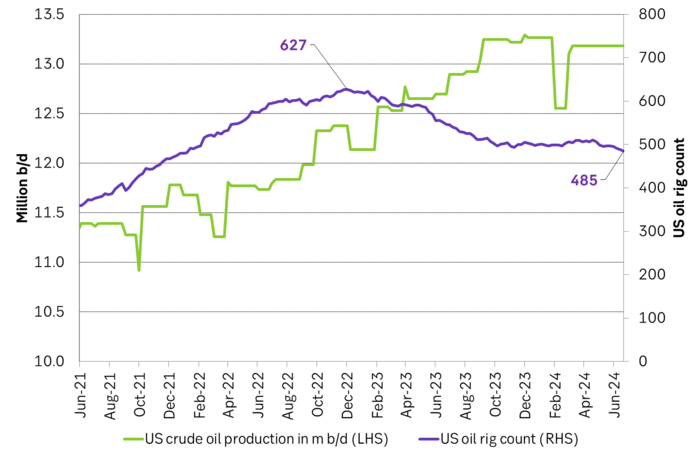
-

 Nyheter7 dagar sedan
Nyheter7 dagar sedanDe tre bästa råvaruvaruaktierna just nu
-

 Nyheter2 veckor sedan
Nyheter2 veckor sedanLundin Mining vill köpa Filo Corp tillsammans med BHP
-

 Nyheter4 veckor sedan
Nyheter4 veckor sedanAfrica Oil är bra att köpa anser Stifel som inleder analysbevakning
-
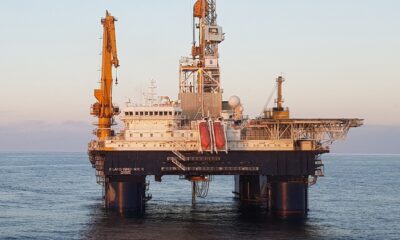
 Nyheter3 veckor sedan
Nyheter3 veckor sedanStor risk att Africa Energy inte överlever det kommande året
-
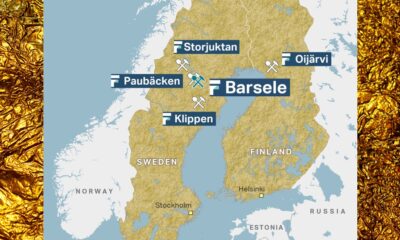
 Nyheter4 veckor sedan
Nyheter4 veckor sedanFirst Nordic Metals har fyra prospekteringsprojekt i Sverige
-

 Analys4 veckor sedan
Analys4 veckor sedanBrent crude inching higher on optimism that US inflationary pressures are fading
-

 Nyheter2 veckor sedan
Nyheter2 veckor sedanUniper satsar på att göra elektrobränsle av sin elektricitet
-

 Nyheter2 veckor sedan
Nyheter2 veckor sedanTre bra aktier inom olja och oljeservice i Kanada


